AMD's Ryzen 9 6900HS Rembrandt Benchmarked: Zen3+ Power and Performance Scaling
by Dr. Ian Cutress on March 1, 2022 9:30 AM ESTOffice and Science
In this version of our test suite, all the science focused tests that aren’t ‘simulation’ work are now in our science section. This includes Brownian Motion, calculating digits of Pi, molecular dynamics, and for the first time, we’re trialing an artificial intelligence benchmark, both inference and training, that works under Windows using python and TensorFlow. Where possible these benchmarks have been optimized with the latest in vector instructions, except for the AI test – we were told that while it uses Intel’s Math Kernel Libraries, they’re optimized more for Linux than for Windows, and so it gives an interesting result when unoptimized software is used.
Agisoft Photoscan 1.3.3: link
The concept of Photoscan is about translating many 2D images into a 3D model - so the more detailed the images, and the more you have, the better the final 3D model in both spatial accuracy and texturing accuracy. The algorithm has four stages, with some parts of the stages being single-threaded and others multi-threaded, along with some cache/memory dependency in there as well. For some of the more variable threaded workload, features such as Speed Shift and XFR will be able to take advantage of CPU stalls or downtime, giving sizeable speedups on newer microarchitectures.
For the update to version 1.3.3, the Agisoft software now supports command line operation. Agisoft provided us with a set of new images for this version of the test, and a python script to run it. We’ve modified the script slightly by changing some quality settings for the sake of the benchmark suite length, as well as adjusting how the final timing data is recorded. The python script dumps the results file in the format of our choosing. For our test we obtain the time for each stage of the benchmark, as well as the overall time.
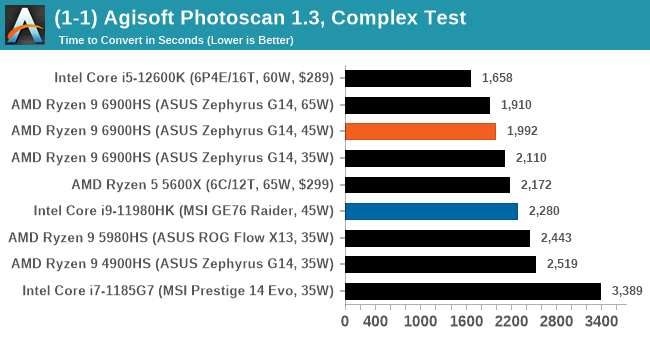
GeekBench 5: Link
As a common tool for cross-platform testing between mobile, PC, and Mac, GeekBench is an ultimate exercise in synthetic testing across a range of algorithms looking for peak throughput. Tests include encryption, compression, fast Fourier transform, memory operations, n-body physics, matrix operations, histogram manipulation, and HTML parsing.
I’m including this test due to popular demand, although the results do come across as overly synthetic, and a lot of users often put a lot of weight behind the test due to the fact that it is compiled across different platforms (although with different compilers).
We have both GB5 and GB4 results in our benchmark database. GB5 was introduced to our test suite after already having tested ~25 CPUs, and so the results are a little sporadic by comparison. These spots will be filled in when we retest any of the CPUs.
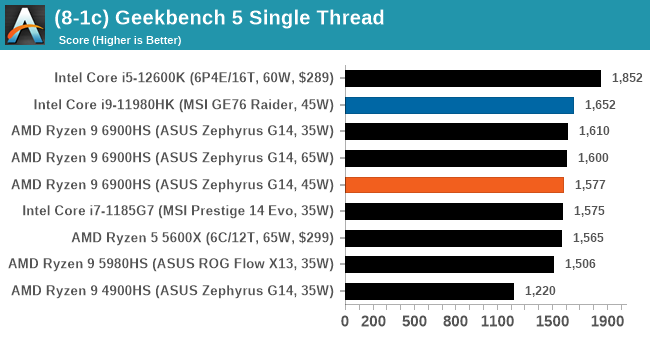
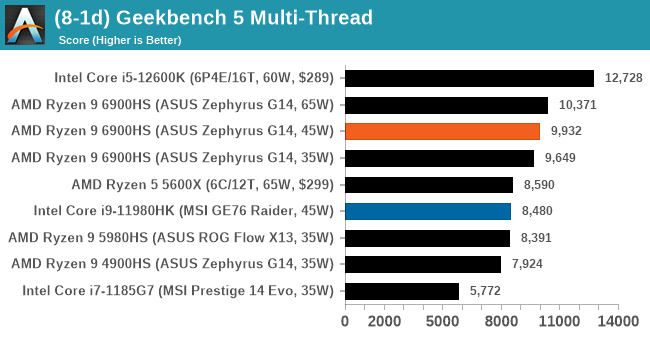
We saw a few instances where the 35W/45W results were almost identical, with the margin that the 35W would come out ahead in single threaded tasks. This may be because 35W was a fixed setting in the software options, whereas 45W was the power management framework in action.
NAMD 2.13 (ApoA1): Molecular Dynamics
One of the popular science fields is modeling the dynamics of proteins. By looking at how the energy of active sites within a large protein structure over time, scientists behind the research can calculate required activation energies for potential interactions. This becomes very important in drug discovery. Molecular dynamics also plays a large role in protein folding, and in understanding what happens when proteins misfold, and what can be done to prevent it. Two of the most popular molecular dynamics packages in use today are NAMD and GROMACS.
NAMD, or Nanoscale Molecular Dynamics, has already been used in extensive Coronavirus research on the Frontier supercomputer. Typical simulations using the package are measured in how many nanoseconds per day can be calculated with the given hardware, and the ApoA1 protein (92,224 atoms) has been the standard model for molecular dynamics simulation.
Luckily the compute can home in on a typical ‘nanoseconds-per-day’ rate after only 60 seconds of simulation, however we stretch that out to 10 minutes to take a more sustained value, as by that time most turbo limits should be surpassed. The simulation itself works with 2 femtosecond timesteps. We use version 2.13 as this was the recommended version at the time of integrating this benchmark into our suite. The latest nightly builds we’re aware have started to enable support for AVX-512, however due to consistency in our benchmark suite, we are retaining with 2.13. Other software that we test with has AVX-512 acceleration.
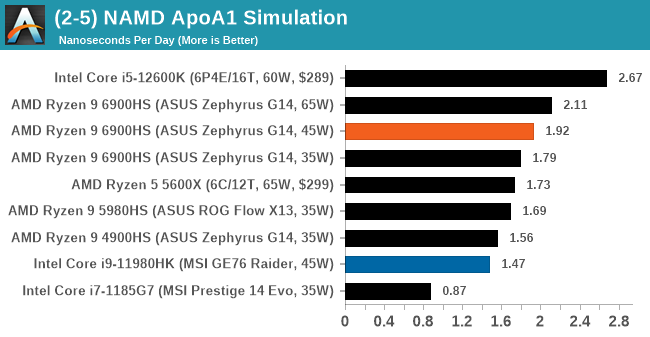
AI Benchmark 0.1.2 using TensorFlow: Link
Finding an appropriate artificial intelligence benchmark for Windows has been a holy grail of mine for quite a while. The problem is that AI is such a fast moving, fast paced word that whatever I compute this quarter will no longer be relevant in the next, and one of the key metrics in this benchmarking suite is being able to keep data over a long period of time. We’ve had AI benchmarks on smartphones for a while, given that smartphones are a better target for AI workloads, but it also makes some sense that everything on PC is geared towards Linux as well.
Thankfully however, the good folks over at ETH Zurich in Switzerland have converted their smartphone AI benchmark into something that’s useable in Windows. It uses TensorFlow, and for our benchmark purposes we’ve locked our testing down to TensorFlow 2.10, AI Benchmark 0.1.2, while using Python 3.7.6.
The benchmark runs through 19 different networks including MobileNet-V2, ResNet-V2, VGG-19 Super-Res, NVIDIA-SPADE, PSPNet, DeepLab, Pixel-RNN, and GNMT-Translation. All the tests probe both the inference and the training at various input sizes and batch sizes, except the translation that only does inference. It measures the time taken to do a given amount of work, and spits out a value at the end.
There is one big caveat for all of this, however. Speaking with the folks over at ETH, they use Intel’s Math Kernel Libraries (MKL) for Windows, and they’re seeing some incredible drawbacks. I was told that MKL for Windows doesn’t play well with multiple threads, and as a result any Windows results are going to perform a lot worse than Linux results. On top of that, after a given number of threads (~16), MKL kind of gives up and performance drops of quite substantially.
So why test it at all? Firstly, because we need an AI benchmark, and a bad one is still better than not having one at all. Secondly, if MKL on Windows is the problem, then by publicizing the test, it might just put a boot somewhere for MKL to get fixed. To that end, we’ll stay with the benchmark as long as it remains feasible.
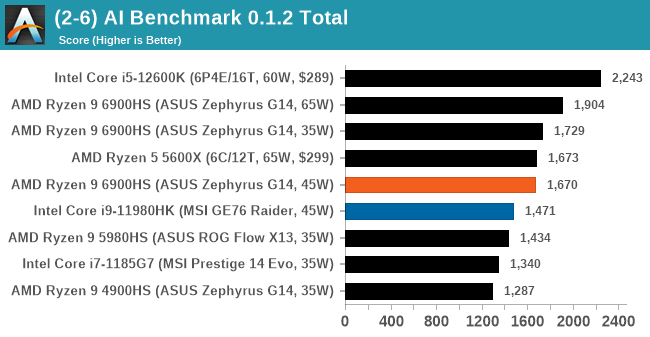
We saw a few instances where the 35W/45W results were almost identical, with the margin that the 35W would come out ahead in single threaded tasks. This may be because 35W was a fixed setting in the software options, whereas 45W was the power management framework in action.
3D Particle Movement v2.1: Non-AVX and AVX2/AVX512
This is the latest version of this benchmark designed to simulate semi-optimized scientific algorithms taken directly from my doctorate thesis. This involves randomly moving particles in a 3D space using a set of algorithms that define random movement. Version 2.1 improves over 2.0 by passing the main particle structs by reference rather than by value, and decreasing the amount of double->float->double recasts the compiler was adding in.
The initial version of v2.1 is a custom C++ binary of my own code, and flags are in place to allow for multiple loops of the code with a custom benchmark length. By default this version runs six times and outputs the average score to the console, which we capture with a redirection operator that writes to file.
For v2.1, we also have a fully optimized AVX2/AVX512 version, which uses intrinsics to get the best performance out of the software. This was done by a former Intel AVX-512 engineer who now works elsewhere. According to Jim Keller, there are only a couple dozen or so people who understand how to extract the best performance out of a CPU, and this guy is one of them. To keep things honest, AMD also has a copy of the code, but has not proposed any changes.
The 3DPM test is set to output millions of movements per second, rather than time to complete a fixed number of movements.
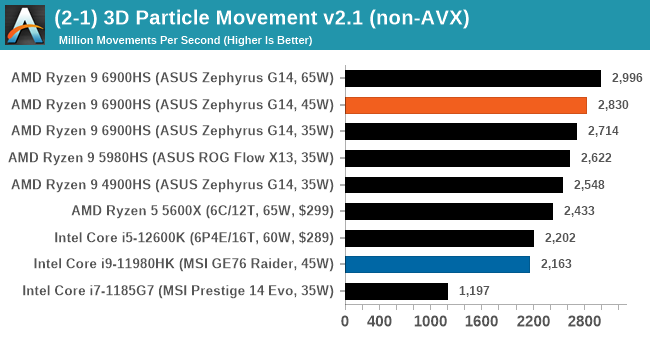

y-Cruncher 0.78.9506: www.numberworld.org/y-cruncher
If you ask anyone what sort of computer holds the world record for calculating the most digits of pi, I can guarantee that a good portion of those answers might point to some colossus super computer built into a mountain by a super-villain. Fortunately nothing could be further from the truth – the computer with the record is a quad socket Ivy Bridge server with 300 TB of storage. The software that was run to get that was y-cruncher.
Built by Alex Yee over the last part of a decade and some more, y-Cruncher is the software of choice for calculating billions and trillions of digits of the most popular mathematical constants. The software has held the world record for Pi since August 2010, and has broken the record a total of 7 times since. It also holds records for e, the Golden Ratio, and others. According to Alex, the program runs around 500,000 lines of code, and he has multiple binaries each optimized for different families of processors, such as Zen, Ice Lake, Sky Lake, all the way back to Nehalem, using the latest SSE/AVX2/AVX512 instructions where they fit in, and then further optimized for how each core is built.
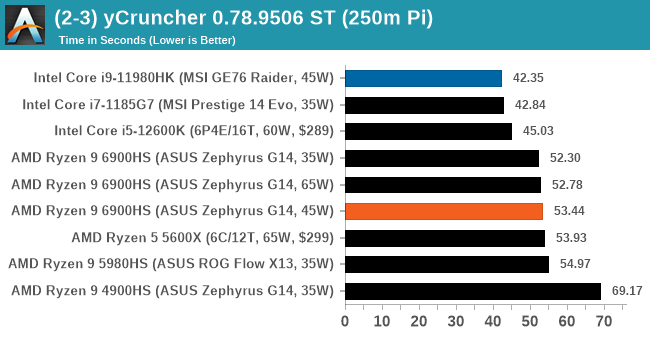
For our purposes, we’re calculating Pi, as it is more compute bound than memory bound. In single thread mode we calculate 250 million digits, while in multithreaded mode we go for 2.5 billion digits. That 2.5 billion digit value requires ~12 GB of DRAM, and so is limited to systems with at least 16 GB.
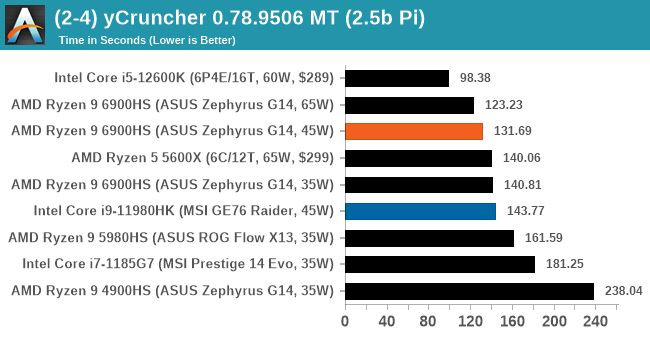










92 Comments
View All Comments
ingwe - Tuesday, March 1, 2022 - link
While I understand not looking at battery life in this, not looking at graphics is a big miss._abit - Tuesday, March 1, 2022 - link
Back to pimping intel ever so gentlySarahKerrigan - Tuesday, March 1, 2022 - link
In 35/45W laptops, including this one, a dGPU will generally be present, making it a little moot. I expect more of a focus on graphics in the 15W review.Kangal - Wednesday, March 2, 2022 - link
Not at all.Most laptops (+80%) are below 45W TDP and they don't have a dGPU, and rely on the iGPU. It's a shame AMD has dragged their heels in this segment. For that reason, RDNA-2 is a substantial upgrade for most laptop users, but if you want a thick, heavy, Gaming Laptop then you are better off with the (12th-gen) Intel CPU and Nvidia dGPU (GeForce 30).
Besides, I see AMD's tech as eras:
2015-era, 16nm, Zen1, Vega Graphics
2018-era, 8nm, Zen2, RDNA-1 graphics
2021-era, 6nm, Zen3, RDNA-2 graphics
2024-era, 4nm, Zen4, RDNA-3 graphics
...roughly speaking (obviously years don't align)
And someone earlier asked how do these different GPU architectures compare. It's hard to do a true Potatoes-to-Potatoes comparison. However, from my understanding of the latest options it goes:
Qualcomm Adreno 7th-gen > Apple Graphics M1 > PowerVr IMG B-series > AMD RDNA-2 > Nvidia Ampere > ARM Mali Valhall 4th-gen > Intel Xe 1st-gen.
...obviously even the latest 4nm Adreno 730 when maxed out at 10W TDP, is no match against an older 8nm RTX 3050 that is thermal limited to only 100W TDP.
cbutters - Tuesday, March 1, 2022 - link
I hate to say it, but I agree.... this is literally one of the biggest step increases in iGPU performance; EVER, and nobody is talking about it. Why? Does Intel have input on how these articles are written? Or does it contribute to the ad revenue and people are wary of disrupting that? Its literally the MOST interesting thing about this CPU.JasonMZW20 - Tuesday, March 1, 2022 - link
Mostly because these systems ship with dGPUs. The iGPU in mobile Ryzen 6000 is a nice upgrade and simply demolishes anything Intel offers, currently.The mainstream 15-28W article should focus on iGPU, as these won't ship with dGPUs, usually. This is the meat of the market, and a good iGPU is critical to a good experience.
AMD's mobile strategy seems to be a quick-iterative design. Renoir and Cezanne were nearly on top of each other, as Cezanne came back from the fab just as Renoir shipped. So, with mobile Ryzen 6000/Rembrandt, AMD offers a new iGPU+(LP)DDR5 rather than new CPU cores, plus SoC optimizations overall.
The one thing that bothers me about the RDNA2 iGPU is that AMD disables an entire shader array in the 6600U instead of simply turning off 2 WGPs (4 CUs). So, there's a sharp performance drop between the two models and 6600U will be the primary volume seller, I think. 12 CUs to 6 CUs, instead of 12 -> 8 -> 6.
DannyH246 - Tuesday, March 1, 2022 - link
Honestly it’s been like this for a while now. Just go to the home page and count how many Intel marketing articles we’ve had over the last couple months. Now we get a half arsed joke of a review like this on AMD hardware. Obviously in Intel’s pocket.29a - Tuesday, March 1, 2022 - link
Typical half assed AMD article.DannyH246 - Tuesday, March 1, 2022 - link
Next headline article on www.IntelTech.com….Breaking news Intel CEO Gelsinger breaks wind.
Qasar - Wednesday, March 2, 2022 - link
DannyH246 i see you cry about this all the time, if anandtech is that bad, WHY do you keep coming here ? is it just to whine and cry?? im sure you will just reply with some sort of BS, but it HAS been stated before, there are times when most articles are intel, and others are AMD, its just the way the cycles go.